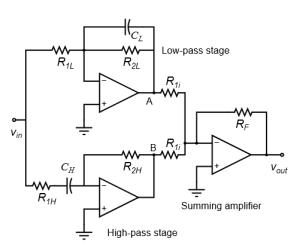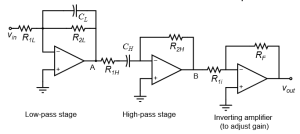Signal acquisition and processing
The bioelectrical activities emanating from the muscles are obtained using EMG electrodes; surface electrodes being most common. Surface electrodes are placed over the body after applying an electrolytic gel, so as to help in conduction.
EMG signals are weak signals with an amplitude range of 0-10 mV. The frequency range of these signals is from 0 to 500 Hz, with the dominant power spectrum lying in the range of 50-150 Hz. These signals are highly prone to noise like ECG crosstalk, electromagnetic induction from power lines, motion artifacts etc.
Right Leg Driver Circuit
The right leg driver circuit is used to bring down common mode voltage. It also helps in reducing motion artifacts. It also reduces the effective electrode resistance and constitutes to the overall stability of the amplifier circuit. The DC offset of the acquired signal may result in damage of equipment. It can be avoided with the use of a capacitive DC blocking stage.
Band stop filter
Disturbance due to electromagnetic interference from power lines usually lie in the range of 50-60 Hz. A properly implemented band stop filter of suitable order can be used to get rid of this problem.
A simple band stop filter is implemented as shown:

It is implemented as a parallel combination of a low pass and high pass filter.
Its active implementation is shown as such:
Band pass filter
Studies show that the dominant frequency range of EMG signal is 20-500Hz. A band pass filter is usually realized at the input side in order to attenuate signal lying outside the dominant frequency range.
Its hardware implementation is realized as shown, with a low pass and high pass filter in cascade.
The center frequency ωc 2= ωLS ωHS; where ωHS = 1/R1HCH and ωLS = 1/R2LCL .
Such a filter can be realized at the software level in matlab, labview etc ideally.


